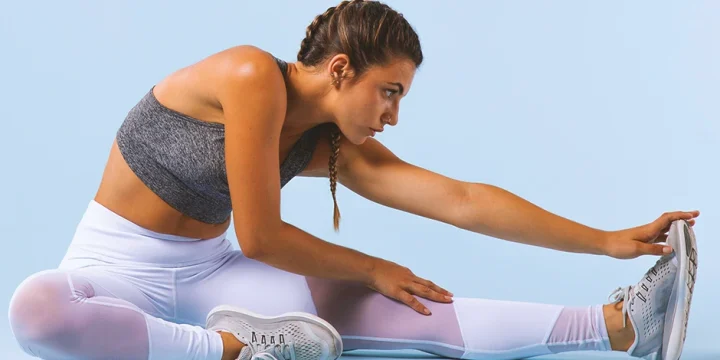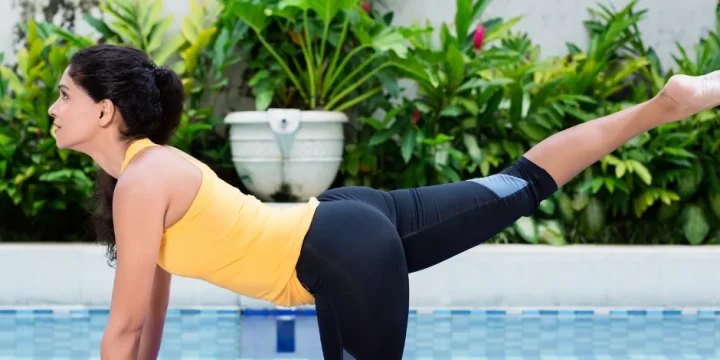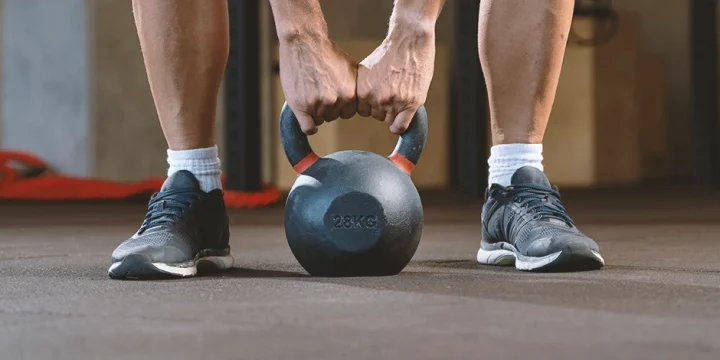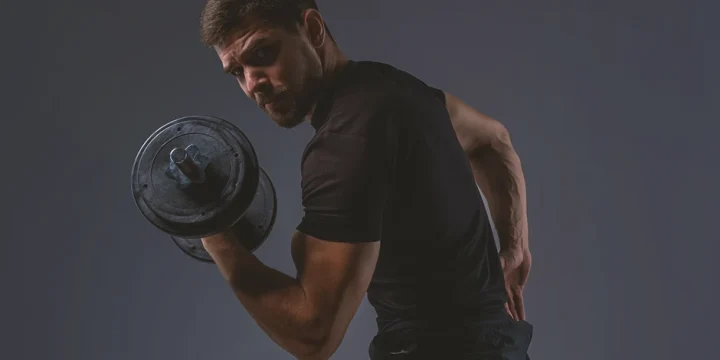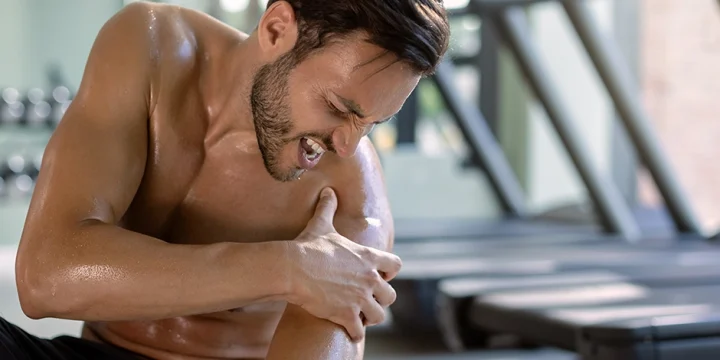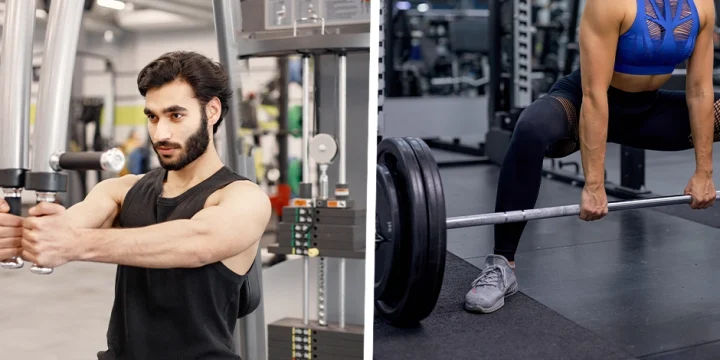Quick Summary
- The best free-weight exercises include overhead triceps extensions, upright rows, half-squats, etc.
- Each exercise, such as the overhead triceps extension and upright rows, requires specific body positioning and movement to effectively target muscles like the triceps, shoulders, and upper traps.
- A study in the Brain Science Journal highlights that free weights mimic everyday activities, enhancing power, strength, and coordination.
- Drawing from my extensive coaching experience, I find free weights to be a dynamic and adaptable tool in strength training, catering to a wide range of fitness needs and objectives.
The Best Free Weight Exercises

Overhead Tricep Extension
From my experience, the triceps extension stands out as the best dumbbell exercise for isolating and strengthening the upper arm muscles.
Standing triceps extension requires you to use your core to support your lower and mid-body while simultaneously moving both arms above your head.
How to perform:
- Start standing with both feet shoulder-width apart. You may enhance your balance by using a slight split stance, with your left leg slightly behind your right.
- The weight should be distributed evenly between both feet.
- Soften your knees and keep the core engaged to maintain proper posture throughout the movement.
- Raise the dumbbell overhead. Ensure your head is positioned over your chest, your core is engaged, and your shoulders are relaxed.
- Extend both hands full, then slowly drop the load behind your head by bending at the elbows. Ensure the chest remains straight over the hips and the back does not flare.
- Inhale and reverse the action once you achieve a 90-degree bend at your elbow or slightly beyond, raising the load back to the starting position.
- Repeat for reps.
Related: Dumbbell Tricep Extensions: Technique, Form and Variations
Upright Rows
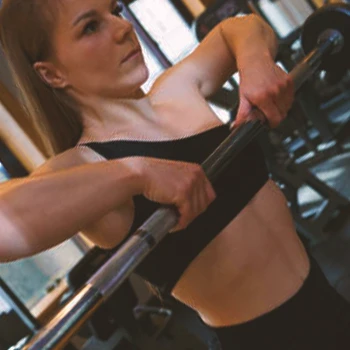
In my training sessions, I've found the barbell upright row to be incredibly effective for building shoulder and upper trap strength.
How to perform:
- Load a barbell with the desired weight plates and stand before it with both feet shoulder-width apart.
- Hold the barbell using an overhand grip (palms facing down) and hands a bit closer than shoulder-width apart.
- Pick up the bar with your knees bent and your back straight.
- Raise the bar straight up while maintaining your back straight and your eyes ahead, keeping it as near your torso as possible (you ought to bring the bar up to roughly chest height—close to your chin).
- After a little pause, steadily lower the barbell back to its starting position.
- Repeat for reps.
Related Posts:
Half Squats
While the optimum breadth, foot, and barbell position may vary depending on the individual, there are broad signals that most individuals can follow when executing squats.
Consider adding a halt at the bottom of the half squat before returning to standing if you want to concentrate on your sticking point, particularly breaking through a plateau.
How to perform:
- Place your feet shoulder-width apart, facing ahead with a little outward slant.
- Make an arch in the leg by pushing down with the heel, the bottom of the first toe, and the tip of your fifth toe to form a tripod—this will give stability and even weight distribution.
- Bring the chest forward and engage the hamstrings and glutes as you drive both hips backward into a hip hinge.
- Squeeze the glutes and drive both knees out to produce strain and external rotation in the hips. You should be able to feel the outer hips engage.
- Maintain an upright, neutral posture with your neck and torso. Look ahead at a modest downward angle.
- Descend to the target position, parallel or slightly above, while remaining balanced and evenly distributing your weight on your feet. The shins should be as upright as feasible for a half squat.
- Return to the starting position by pushing your hips up and back and vertically pushing your shins.
- Repeat for reps.
Dumbbell Bench Press
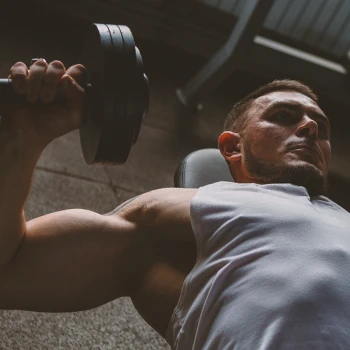
Having coached many clients, I can attest that the bench press is not just an excellent upper-body workout; it's a comprehensive full-body dumbbell workout that enhances overall strength.
The dumbbell bench press may assist you in increasing overall strength in preparation for other workouts, such as the push-up.
How to perform:
- Take a medium-weight dumbbell in each hand.
- Squeeze your elbows close to your ribs and slowly drop your torso onto the bench to lay face up, knees bent, and dumbbells in front of your armpits.
- Extend your elbows to the sides so that your triceps form a 45- or 70-degree angle to your body. Engage your core and press your feet flat against the floor. This is your starting point.
- Exhale and press the weights away from your chest, straightening your arms so they are squarely above your shoulders.
- On an inhale, carefully lower the weights back to the starting position, stopping when the dumbbells are just over the shoulders.
- Repeat for reps.
Tricep Kickbacks
The triceps kickback allows you to concentrate on sculpting detail into your hand muscles.
Among the many tricep dumbbell exercises, this has the potential to assist us in concentrating on that ultimate squeeze.
"Your triceps' job is to maintain your arms straight at the elbow at maximum tension. So, much like we'd squeeze the biceps at the peak of a strong biceps curl for maximum benefits, squeeze the tris when your arm is straight during a kickback."
- Ebenezer Samuel, Certified Strength & Conditioning Specialist
How to perform:
- Stand with both feet shoulder-width apart, your knees slightly bent at around 25 degrees, holding a dumbbell in each hand.
- Raise the dumbbells behind you until your elbows are 90 degrees bent, then raise them higher until they are parallel with both feet.
- Hold this stance for two counts before lowering to the starting position.
- Repeat for reps.
Dumbbell Step-Up
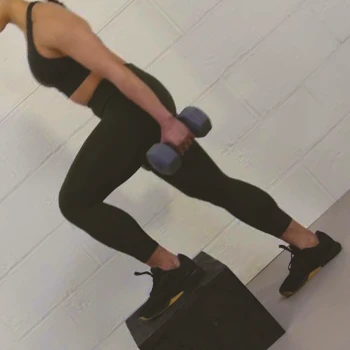
The dumbbell step-up is a lower-body exercise performed by "stepping up" onto a knee-high bench or box while gripping a dumbbell in each hand.
The calves, glutes, hamstrings, quadriceps, and hip adductors are the primary muscles engaged by these dumbbell exercises.
How to perform:
- Prepare the dumbbells step by selecting a pair of dumbbells and grasping them at the sides.
- Stand before a flat seat or other elevated platforms.
- Maintain a forward-facing gaze and a slight bend in both knees. This is your starting point.
- Lift the left knee and place your left foot on the platform.
- When your left foot is firmly planted on the platform, pull your torso up and put your right foot on the platform.
- After a brief pause, step back with the right leg and cautiously return to the starting position.
- Repeat this action for the appropriate number of repetitions, then perform while leading with the right foot.
Bent-Over Row
The bent-over row is one of the greatest muscle-developing back exercises available.
The bent-over row is commonly used to train and develop the upper-body muscles, particularly the back (trapezius, latissimus dorsi, and rhomboids).
A bent-over row, however, needs the support of muscles of the low back, arms, and core.
How to perform:
- Stand with your feet shoulder-width apart with a dumbbell in each hand.
- With your knees bent and the back straight, bend forward from the hips until your body faces the ground.
- Drive the elbows upward and back behind the body till the weights are level with, or slightly higher than, your torso.
- Constrict the top of your shoulder blades as if attempting to squeeze something between them.
- Slowly drop the load back to the initial position in a controlled motion.
- Repeat for reps.
Dumbbell Romanian Deadlift
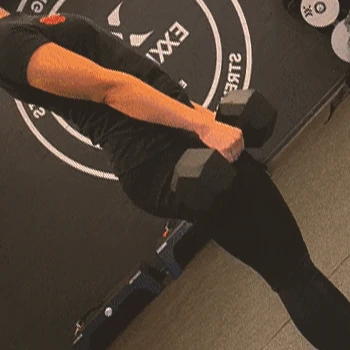
Like the normal deadlift, the Romanian deadlift develops your posterior chain, which comprises the lower back, hamstrings, and glutes.
This technique also requires core activation to gain strength and stability.
How to perform:
- Stand with both feet hip-width apart, your knees relaxed, dumbbells in front of your hips, and your hands facing your thighs.
- Begin sending the hips back while keeping the spine in a neutral posture and squeezing the shoulder blades.
- Dumbbells should be placed in front of the shins, near the torso. Let the hips descend no farther after the dumbbells have passed the knees.
- Maintain your spine neutral at the bottom of the action and drive through heels to completely extend knees and hips, tightening glutes at the top.
How To Maximize Your Training

Set a Goal
In my coaching, I advise clients to clearly define their goals—be it strength, size, or endurance—to tailor their training effectively. For strength and size, go for heavy weights and fewer reps; for endurance, go for lighter weights and more reps.
Set a Schedule
Aim for 4-5 days of training per week, focusing on quality over duration. Avoid repeating the same muscle groups to ensure recovery.
Maintain Order
Start with challenging full-body exercises like squats, then move on to targeted exercises.
Maintain Proper Form
Ensure the correct form to maximize benefits and prevent injuries. Start with your body weight before progressing to heavier weights.
The Benefits

From my experience, free weights excel at challenging muscle stabilization and enhancing functional strength and coordination.
According to a study published in the Brain Science Journal, they mimic everyday activities and allow you to develop power, strength, and coordination in one action [1].
One study published in Experimental Gernotology showed that free weights are especially beneficial for older adults, improving leg and triceps strength when compared to machine training [2].
They are adaptable since they may be used in several locations and techniques. You may adjust your placement to fit any special demands throughout your workout, even in rehabilitation programs for injury recovery.
When you employ free weights:
- Your blood pumps faster, allowing more oxygen and nutrients to move through your body, based on a 2015 study from the Physiological Reviews journal [3].
- You lower your chances of developing health problems like stroke, heart attack, or cardiovascular disorders.
- According to the Adipocyte Journal study, lean muscle aids in the burning of extra body fat throughout the day [4].
- A stronger cardiovascular system aids in better sleep, increasing the quality of your exercises. It is a beneficial cycle for your general health.
- Strength training may assist you in losing weight and breaking through plateaus you may have reached by merely performing cardio, as shown in a study from the Progress in Cardiovascular Disease journal [5].
How Free Weights Differ From Machine Weights
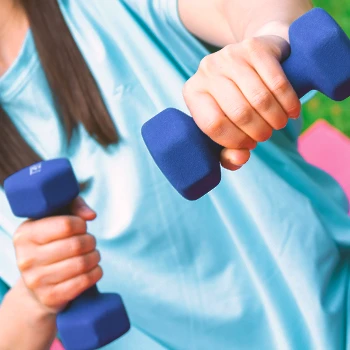
The major distinction between machines and free weights is that machines are set in place and can only move in specific directions, while free weights may be moved in whatever direction the user desires.
They're great for all fitness levels and goals.
Machines are ideal for beginners, teaching form and reducing injury risk, while free weights enhance muscle training and functional fitness.
Plus, freeweights are more practical for home workouts.
Free weights engage more muscles compared to machines, offering similar benefits and more.
"While you may lift more load in the same workout on a machine owing to its fixed structure, free weights provide more bang for the buck in terms of muscle groups engaged."
- Jake Tipane, Certified Personal Trainer
FAQs
Are Free Weights Enough To Build Muscle?
Yes, free weights are enough to build muscle. Free weights engage more muscle groups than machines and, as a result, are superior for muscle growth in the long term.
How Can I Bulk With Free Weights?
You can bulk with free weights by performing exercises such as bench presses, overhead presses, weighted squats, bent-over rows, deadlifts, curls, shrugs, and triceps extensions.
Are 15kg Dumbbells Enough To Build Muscle?
Yes, 15kg dumbbells are enough to build muscle. Developing muscle mass will necessitate bigger weights and fewer reps. Beginners should use 5kg or 10kg dumbbells, while intermediate to experienced users should use 15kg or more.
Supplementing Your Free Weight Exercises
Free-weight workouts require you to engage more muscle areas than weight machines.
To adequately complete a dumbbell or barbell workout, you must completely engage your abdominal muscles, maintain balance, and utilize your stabilizer muscles.
Furthermore, many free-weight workouts perform well as part of an at-home exercise, especially if you have a set of adjustable dumbbells.
Be sure to incorporate the above-mentioned free-weight workouts with these strongest pre-workout supplements into your training session.
The supplements have been scientifically proven to contain ingredients that increase focus. Upon testing, we found that they increased our energy, concentration, and pump required to complete our workouts.
References:
- https://pubmed.ncbi.nlm.nih.gov/33022911/
- https://pubmed.ncbi.nlm.nih.gov/30980922/
- https://www.ncbi.nlm.nih.gov/pmc/articles/PMC4551211/
- https://www.ncbi.nlm.nih.gov/pmc/articles/PMC3661116/
- https://pubmed.ncbi.nlm.nih.gov/24438736/
About The Author
You May Also Like
